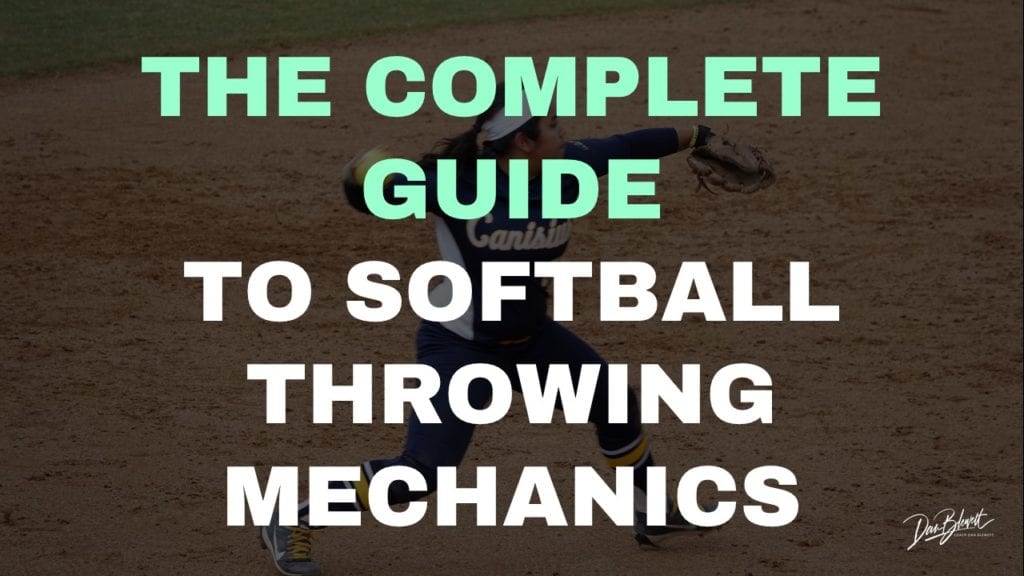*This article may contain product links which pay me a small commission if you make a purchase. Learn more.
How to throw a softball with better technique is a confusing topic, one that too many players and coaches struggle with. In this article, learn everything you need to know today.
If you want to see how you stack up, be sure to watch my video on how fast softball players throw by age.
How do you improve proper softball throwing mechanics? It starts with good fielding technique, then footwork, then the hand break, arm-action and finally acceleration and follow through. Learn it all in this complete guide.
If you’re prefer to watch, I have a great webinar and free softball throwing ebook you can download below.

Fastpitch players should be able to throw 60+ mph in order to get a shot at playing college softball, so it’s a really important skill to develop. Throwing speed also depends on the position you play, so check out my article on each position in softball.
Ih this guide to throwing mechanics, we’ll cover the footwork, arm action, drills, tips, arm strengthening exercises and more.
The Complete Guide to Proper Softball Throwing Mechanics
Jump ahead to any section below using the table of contents. We’ll break this guide down into all of the most important topics that you need to know to leave here today ready to improve outcomes for your fastpitch team.
How do you throw a softball properly? It takes a combination of excellent fielding footwork, great shoulder-hip separation, proper arm action and timing, and strong use of the core and hips.
And be sure to check out this overview video I’ve created:
The table of contents below is clickable.
I’d suggest reading the whole article from top to bottom, but feel free to skip around.
#1: Hand Break Action
When a player has the ball in her glove and goes to break (separate) her hands, the first move needs to be her throwing palm moving down toward the ground as the elbow pulls back, pinching the shoulder blades behind the body.
Good throwing mechanics are about timing, synchronicity of body parts, joint angles and a lot of other little variables.
Hand Break Action: Do This, not That
The hand break action is important because it sets the stage for joint angles being correct and sync of body parts later on in the motion. The way the hands break will affect a LOT of parts downstream, so to speak.
Do This: Palm faces down and hand moves slightly down as elbow pulls back
The first thing that happens after the ground ball is fielded is that it’s brought to the center of the body.
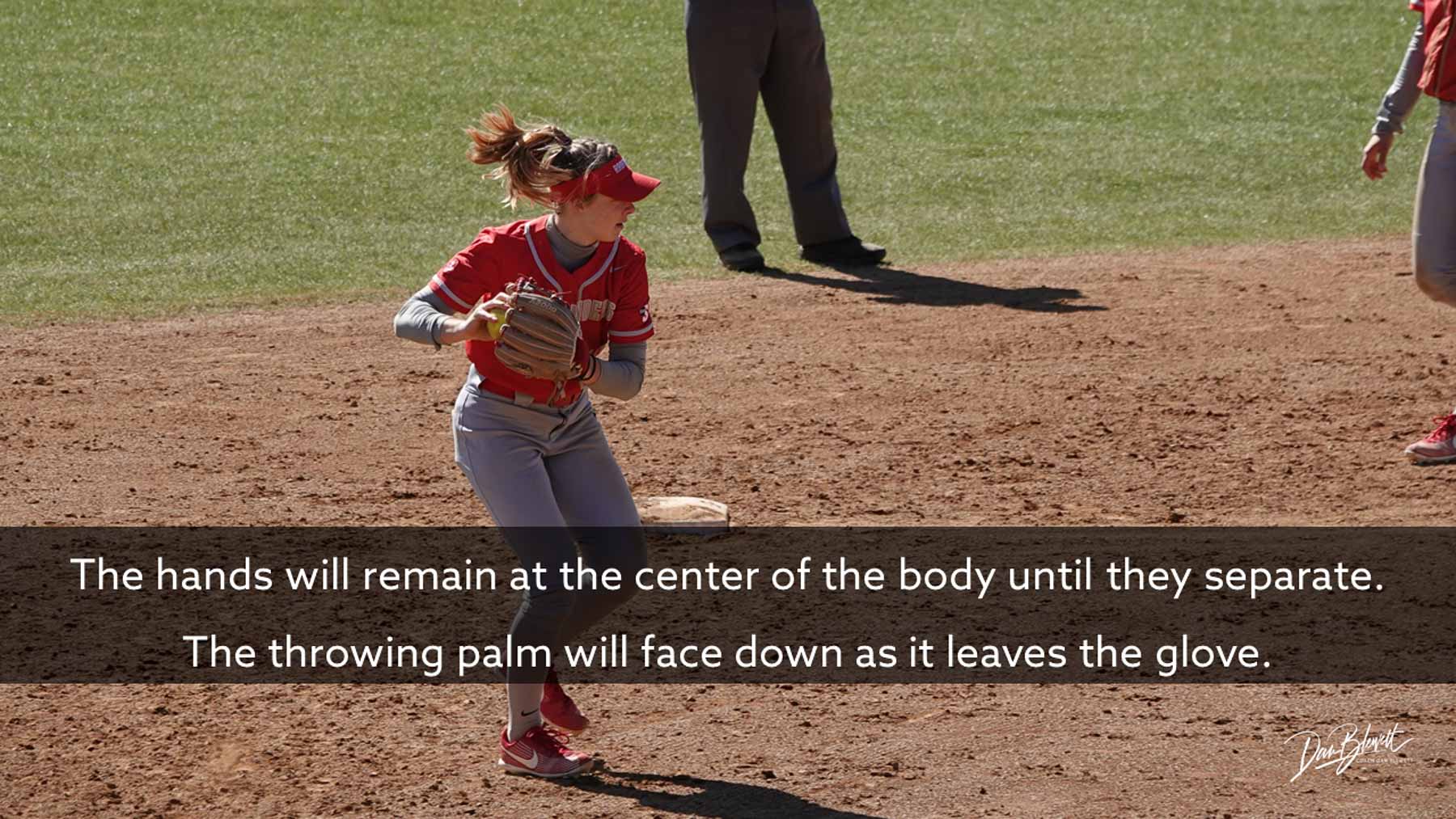
Then, the hands separate, with the throwing hand facing down and the throwing arm pulling back like a bow and arrow.
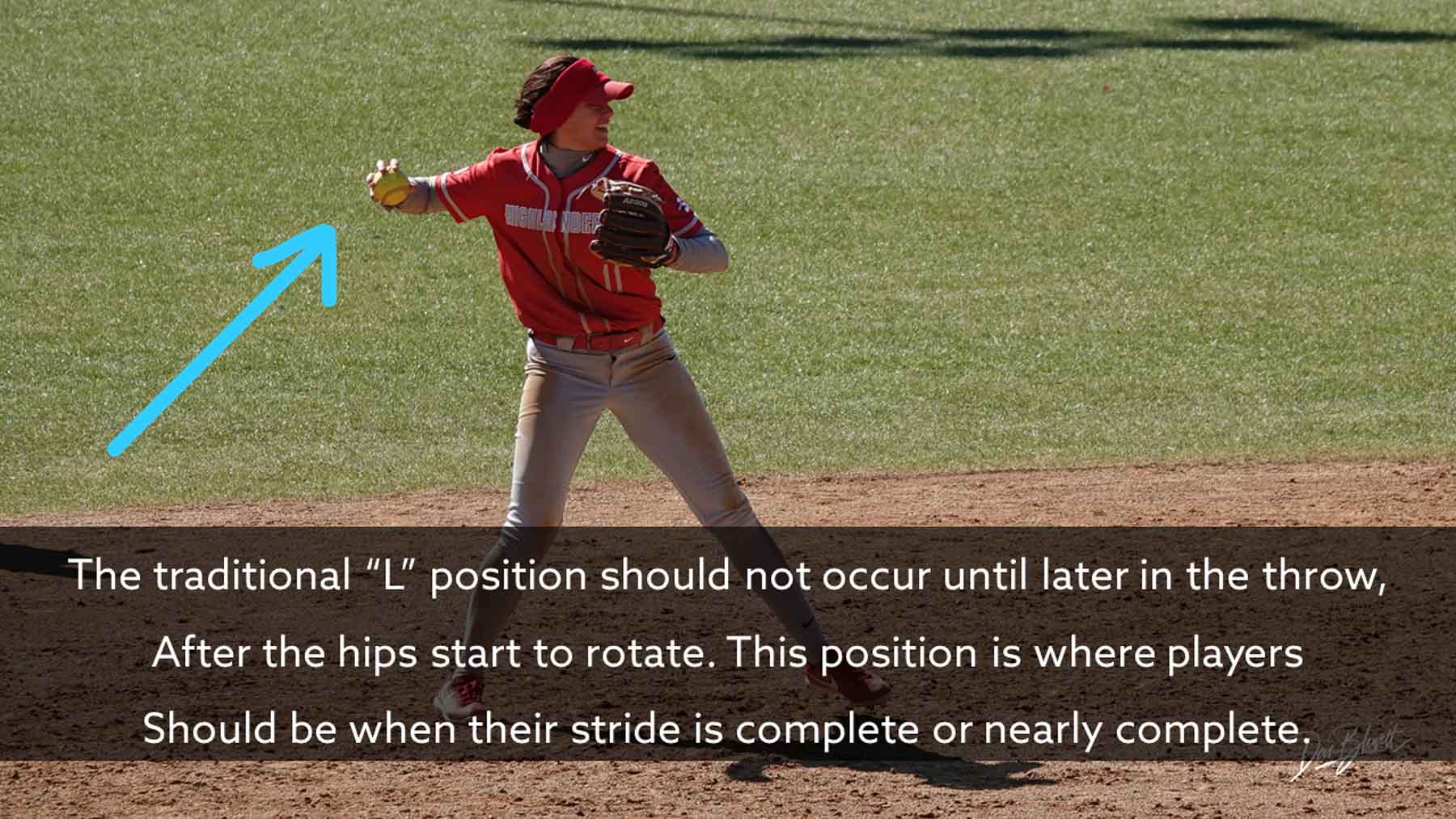
Don’t Do That: Hand moves up and/or palm turns up
Good throwing requires an arm action that doesn’t have extra, long, wasteful movement.
The hand position when the body is ready to start accelerating the ball is one where the palm faces downward, so any other movement in the hand break is wasted and unnecessary.
Watch this Video for More Information
The hand break in the throwing motion is a key part of the delivery, and working on it is an easy way that softball players can throw harder.
#2: Glove Arm Action
The glove arm is VERY important in the throwing motion for all positions in both baseball and softball. Softball throwing isn’t really different than baseball, and we see lots of similarities across both sports.
The Glove Arm: Do this, not That
The glove arm helps the upper body to rotate faster, which adds velocity. And the glove arm has a very important role, which is to basically start the rotation of the hips and upper body.
Many young players struggle with their throwing because their throwing arm goes first instead of their glove arm. For more on this, please watch the video below:
Lots of players struggle with their glove arm action. The glove arm is the “GO!” switch for the hips and core, so working hard to improve it is really important.
Teaching Good Glove Arm Mechanics
For young players, I recommend teaching them to point their glove arm, as shown below. But, this isn’t the only thing the glove arm can do to be “correct.” Softball throwing mechanics are not an exact science.
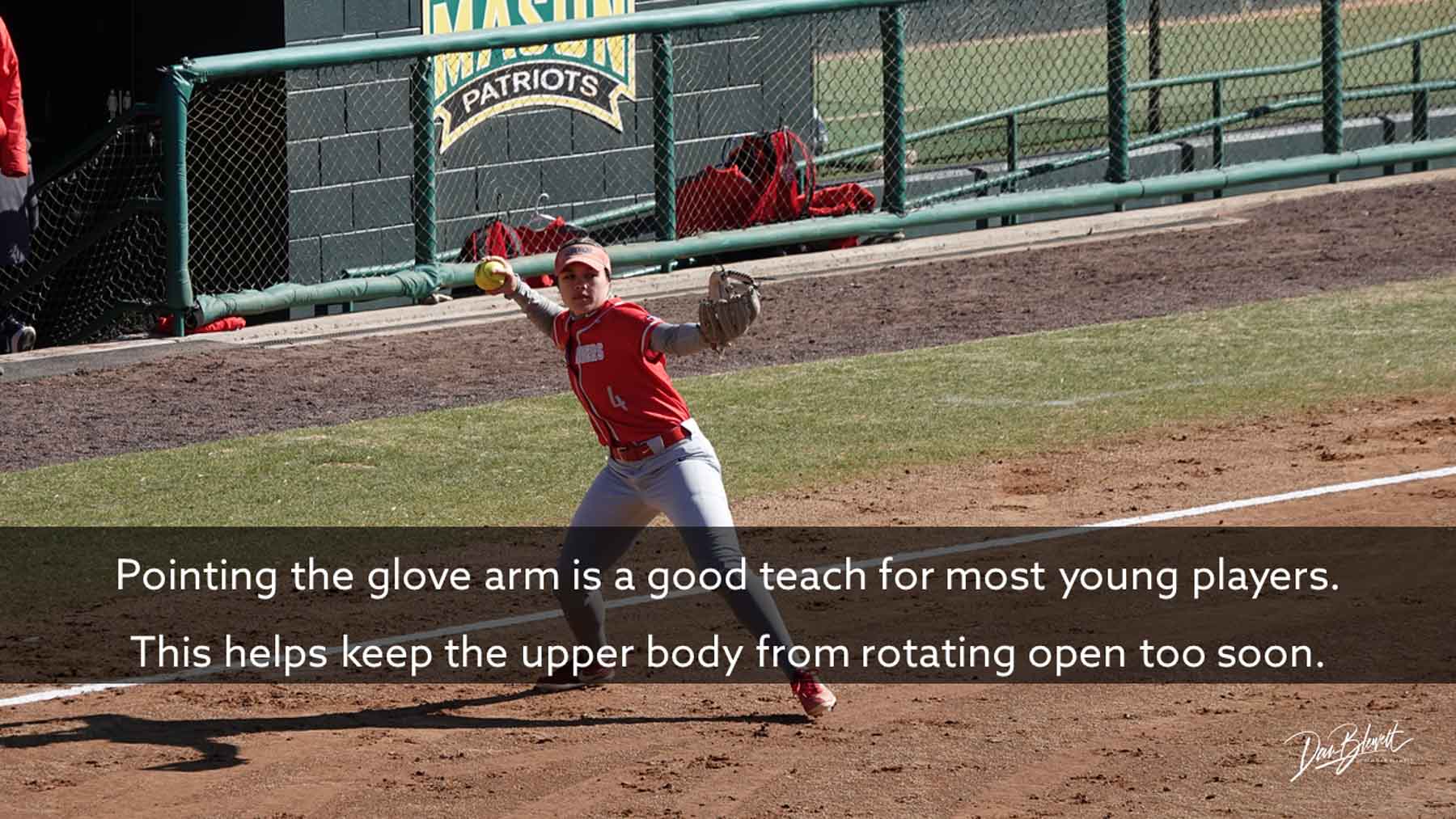
Do This:
- For most players, it’s best to teach them to point their glove arm toward their target
- The glove arm doesn’t have to be fully straight – as long as the upper arm points, they’re in good shape
- The glove arm should rotate completely clear of the body, so that the upper arm ends up vertical, clear of the side
The glove arm has to get clear to the other side of the body – this is it’s job, basically. This is the big thing to look for as a coach – does their glove arm start their throwing motion?
The glove arm should be all the way clear by the time the throwing arm comes through.
Note: Glove Arm Height Can Vary.
Many high-level players–college and pro–have glove arms that swing relatively low, at a downward angle.

Though the low glove arm works for many who are naturally good throwers, low front shoulders are bad for many younger players who are trying to just get to a baseline throwing ability.
I don’t advise teaching it that way, though if a player has a low front shoulder and throws well, I may let it go and not correct it.
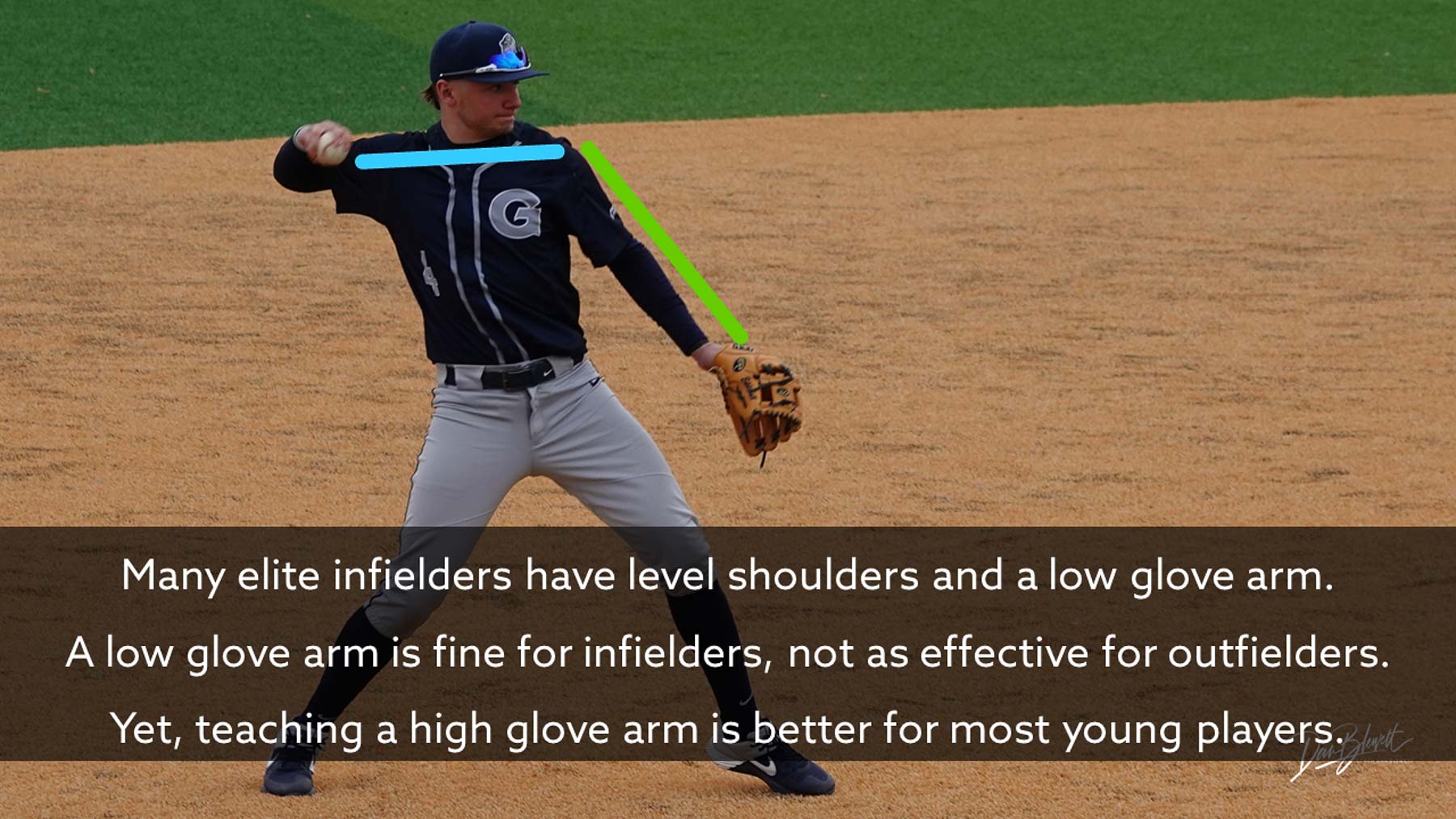
*Understand that sometimes the rules of what good players do/get away with is not the same as what you should teach to a young player who struggles and needs to learn a better way.
Don’t Do That:
- The glove arm should not flop down by the side
- If it rotates too far to the glove side too soon — called “flying open” it will cause the arm angle to drop, often resulting in a sidearm throwing motion
- The glove arm should not “stick” to the chest or stay in front of the body, except when a player is moving through his or her throw. This can cause the glove arm to almost “block” the upper body from rotating properly.
#3: Shoulders Angle Uphill
The shoulders need to be slightly uphill so that the weight is back, then shifts forward at the right time.

In infielders, the uphill shoulders will only apply when throwing over the top, and it will look more subtle in general.

If the shoulders slope downward to the target, it’s an indication that weight has leaked forward too early, much like when a hitter is fooled by an off-speed pitch…the result is bad in both scenarios.
The “uphill shoulders” effect will be:
- Most pronounced and most necessary on outfielders.
- Because they’re running so fast, they have to be very good with keeping their weight back as they go to throw
- Less pronounced but still there on infielders when throwing over the top
- Less pronounced but still there for catchers when throwing over the top
Uphill shoulders will not apply when throwing on the run, or throwing from lower-than-sidearm arm angles.
Having downward angled shoulders, as shown below, is fine when throwing sidearm or throwing on the run. But when throwing over the top, it’s a no-no.
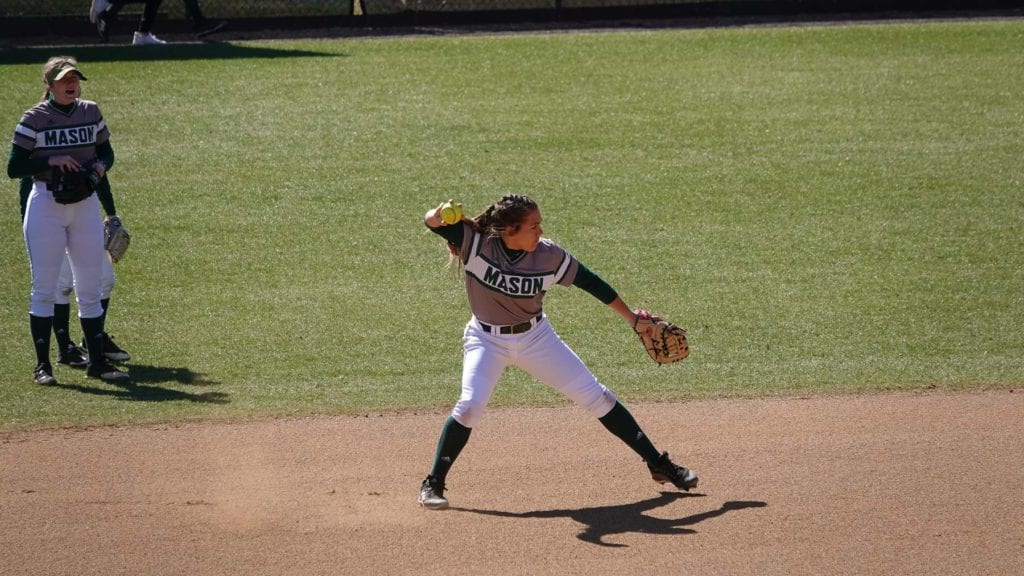
As a coach, pay attention to the slop of the shoulders!
Do This
- Outfielders: Shoulders should angle noticeably uphill as weight shifts to the back leg during the crow hop or pro step footwork
- Infielders and catchers throwing over the top: shoulders should angle slightly uphill as the weight is gathered on the back leg
Don’t Do That
- The shoulders should never slope downward when throwing over the top – this indicates an early, poor weight shift onto the front leg
Throwing sidearm is not bad! It can be natural for many players, and is used as a tool for many others – throwing sidearm is necessary when moving to the right side or throwing on the run toward one’s target.
Learn about sidearm throwing and how the shoulders affect sidearm arm angles.
Understanding how shoulder slope affects arm angle is really important for a coach, so take a long hard look at your players’ throwing shoulder slope at your next practice.
#4: Shoulder Blade Pinch During Arm Action
As the arm action continues beyond the hand break, then next thing that happens is the elbow is pulled back, behind the body. This motion is as if you were trying to elbow someone behind you.
Watch the video below for more on the shoulder blade pinch in the context of your softball throwing mechanics.
The shoulder blade of the throwing arm pinches back first, then as the glove arm clears the body it, too, pinches. This is call “scap-loading”, which just means that the muscles of the shoulder blade (called scapula) are firing.
The shoulder blade pinch is critical to preventing a low elbow
The big flaw that everyone in the softball industry is trying to fix is the low elbow. “Throwing like a girl” (which is not a nice term, by the way) refers to this motion of dropping the elbow and pushing the ball.
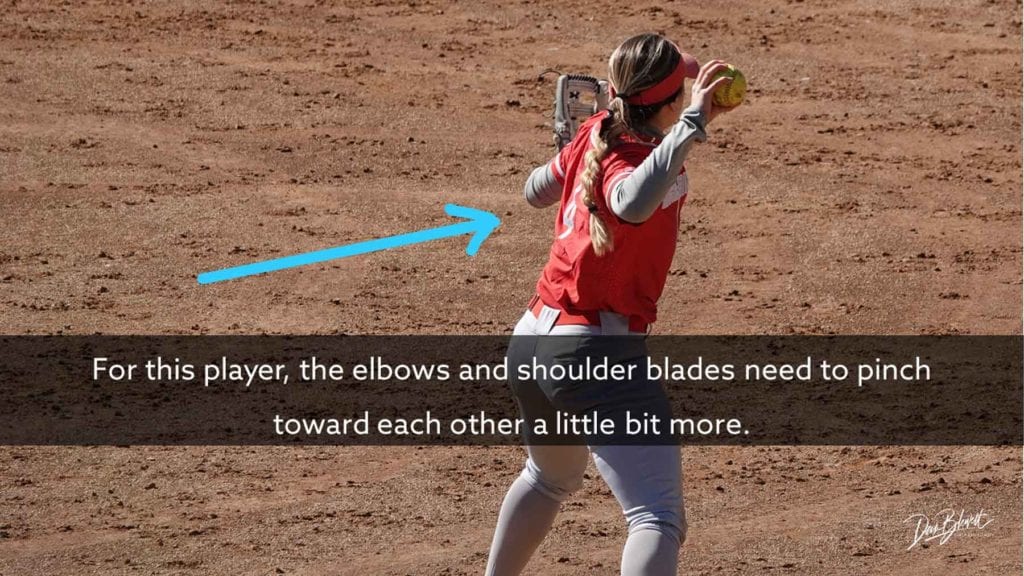
The low elbow, though, is a symptom–not a cause. The cause is often that the shoulder blades don’t pinch behind the body. When the shoulder blades pinch, they essentially provide good synchronicity between body parts and indicate that the glove arm is rotating before the throwing arm, which is important.

Additionally, the shoulder blades pinching “sticks” the throwing arm to the torso, which keeps it more in line with the body as it the hips and torso begin to rotate.
When the arm stays in line with the body, it won’t dip and drop because the hips and torso lead the way, delivering the arm like a whip.
As a coach, you should see the elbows behind the body of the athlete when you’re watching them from straight on.
Do this
- The throwing arm shoulder blade MUST pinch behind the body, which happens by the elbow pulling back
- The arm action is one where the arm moves behind the body, not upward–like is often taught
- A good arm action is a lot like the way a person pulls a bow and arrow – back, not up.
Don’t This
- The arm should not lift or raise up at any time
- The hand will get into throwing position naturally as the shoulder blades draw the arm up
- When the hand gets into the “L position”, its because the shoulder has rotated the arm into it, not lifted it there.
#5: Elbow Angle at Foot Strike
Joint angles are important to throwing harder. For elbow angles, we count the angle the front foot strikes the ground, which we refer to as “foot strike.”

The angle at the elbow makes a big difference in both throwing velocity and accuracy, as well as potential elbow and shoulder pain.
In general, the standard for elbow angle is 90 degrees or less, which is based on American Sports Medicine Institute research on baseball pitchers.
Is there biomechanics data on baseball infielders or softball players? No.
But, we can extrapolate and apply what we learn about angles, stresses and velocities from baseball pitchers and apply those with decent accuracy to softball throwing.
In the end, male or female–we’re all human. Yes, there are differences but throwing is mostly throwing.
If you’re a coach, watch your players – look at the elbow angle and if they’re not at 90 degrees or less, then use the drill below as part of their throwing routine.
The lawnmower drill is a great drill to start a softball throwing progression for teams, as it’s good for any thrower.
#6: Arm Position at Foot Strike
Here we’re looking at a really important checkpoint in the softball throwing motion – the arm’s position at foot strike. This is the position usually thought of as the “L-Position”, which actually doesn’t come until later in the delivery.
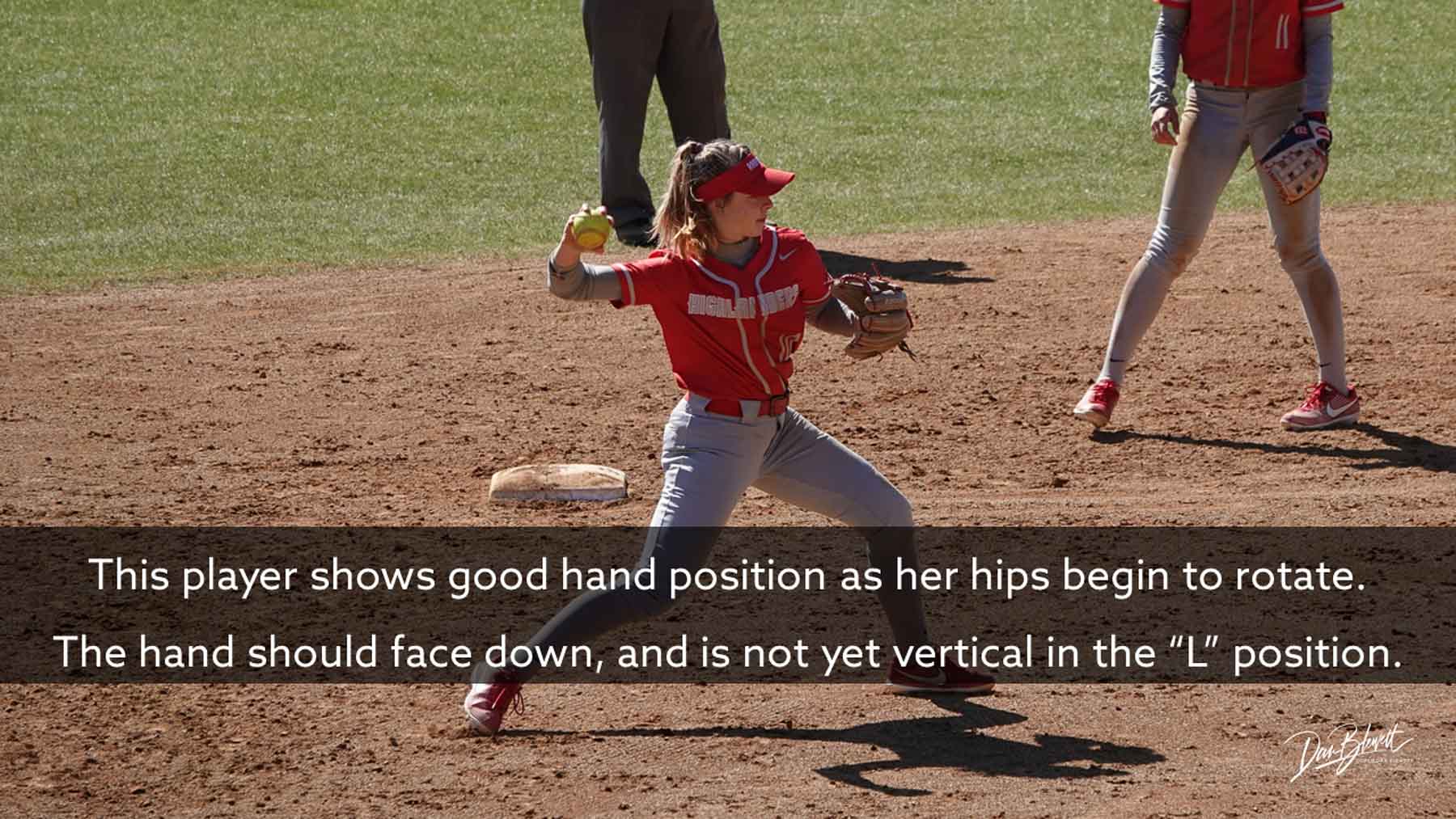
When a player does her crow hop or outfield pro step, the goal is that the hand is slightly above parallel to the ground when their front foot strikes. The throwing arm should NOT be in the L-position, with the forearm and ball sticking straight up in the air–that position comes after the hips begin to rotate.
A great article on this topic specifically is found here on Snap Softball, my softball site.
The position below is commonly thought of as “ready to throw” position, but it’s not.

The throwing arm should NOT be vertical yet when the front foot strikes. Watch the video below for more on this:
Again, timing is everything in life!
#7: Upper Arm Height During Backswing
The upper arm should NOT rise above the line made by the shoulders. This is a common flaw.

When the arm goes too high early, it comes down later, often leading to a low elbow and other problems.
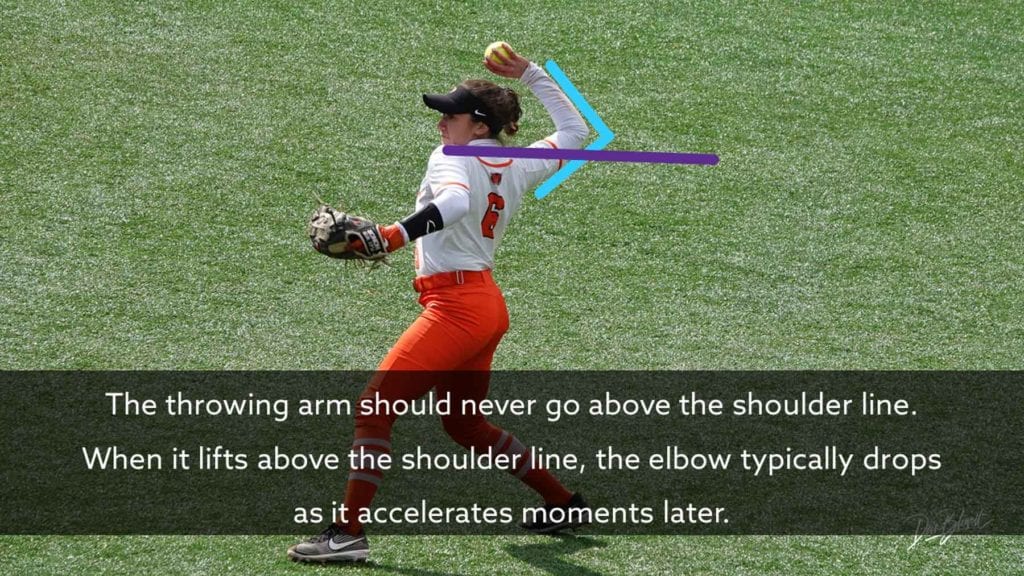
The following is a an example of excellent softball throwing mechanics with regard to throwing arm height and the line the shoulders make:
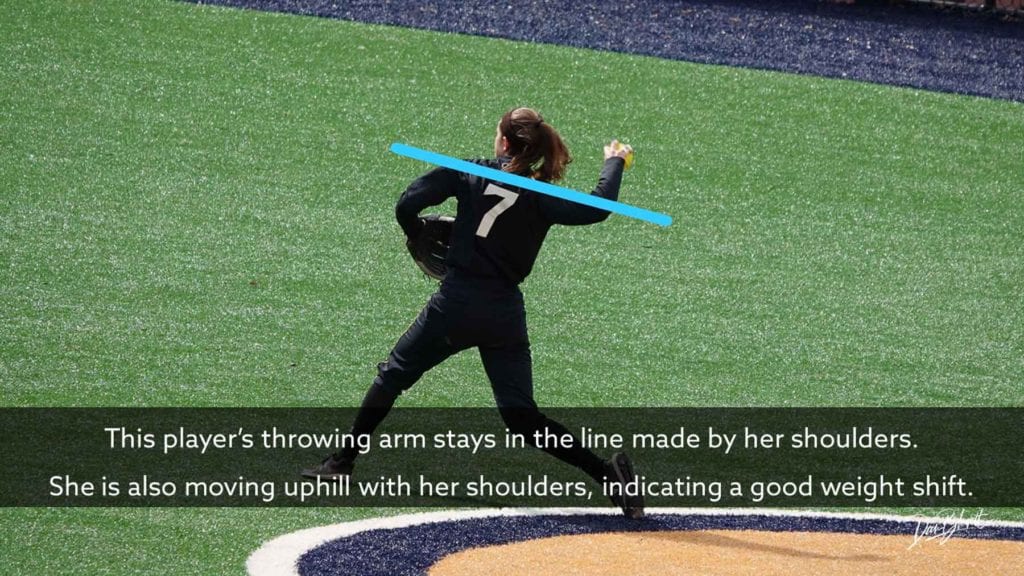
The shoulder-line flaw is improved by the hand break – when the hands pull back, like a bow-and-arrow, the arm won’t rise.
The common teaching point of “GET YOUR ARM UP!” is part of the problem here – when coaches give this order, they’re forcing girls to raise their throwing arm as quickly as possible, which causes huge problems both early and late in the throwing motion.
#8: Stride Length & Body Angle
Stride length is not something that should be measured or talked about too much with softball throwing.
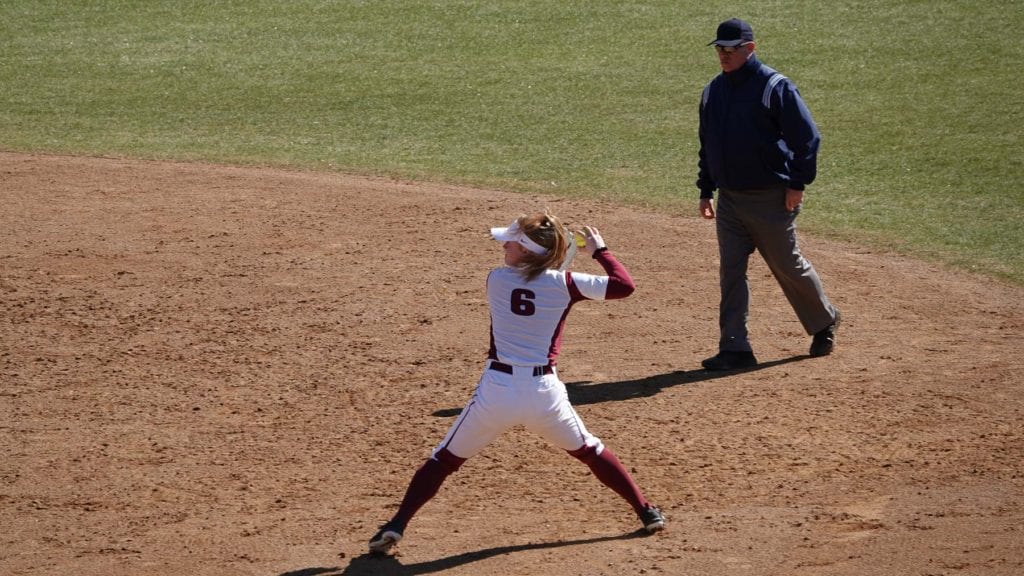
Rather, stride length is a product of:
- How well a player fields, funnels and performs her position-specific crowhop footwork
- How well a player shifts her weight into her back leg
- How well a player slopes her shoulders UPHILL
If she does all of the above, her stride length will work itself out the way it’s supposed to. The body is smart and works together as a system. When the earlier body parts in this system do the right thing, the stride will be the right length for the person. There is no perfect length for all players.
Stride Length Causes Body Angle
The big thing in softball throwing that the stride causes is body angle. We want to use the upper body to our advantage, and when the stride is properly long, the body can shift weight from the back leg to the front leg. This allows the upper body and lower back to fold forward, adding velocity to the arm via the acceleration of the torso.
Basically, when the stride is long enough, the long base of support it creates allows a better, more powerful weight shift and a body angle that is more forward to the target.
A Good Body Angle:
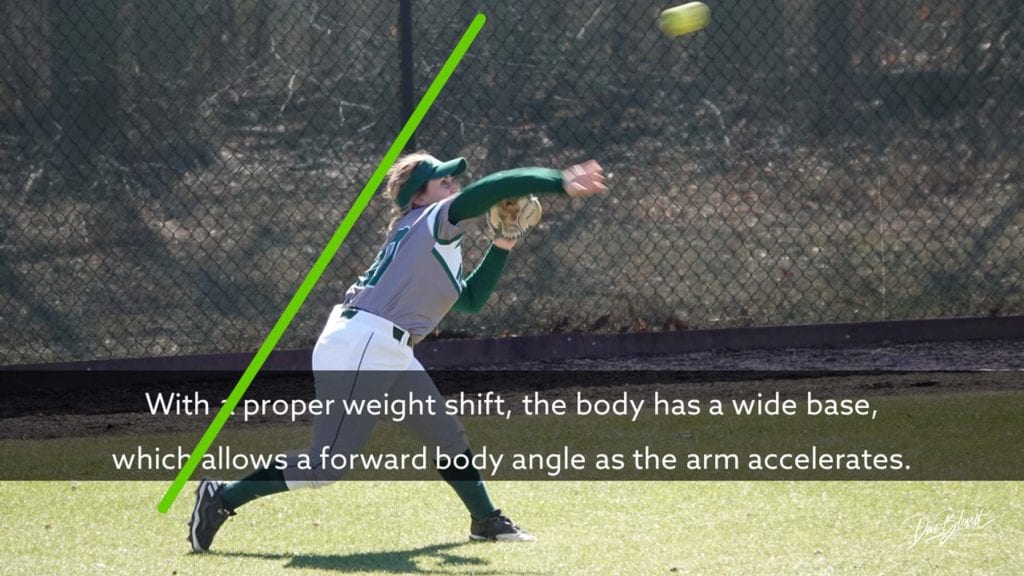
Below is an example of an outfielder who’s weight shift and stride aren’t cutting it – her front leg collapses and her body angle is very tall, which makes her off-balance and unable to throw as hard as she otherwise could. Notice how close her feet are together, as compared to the player above.
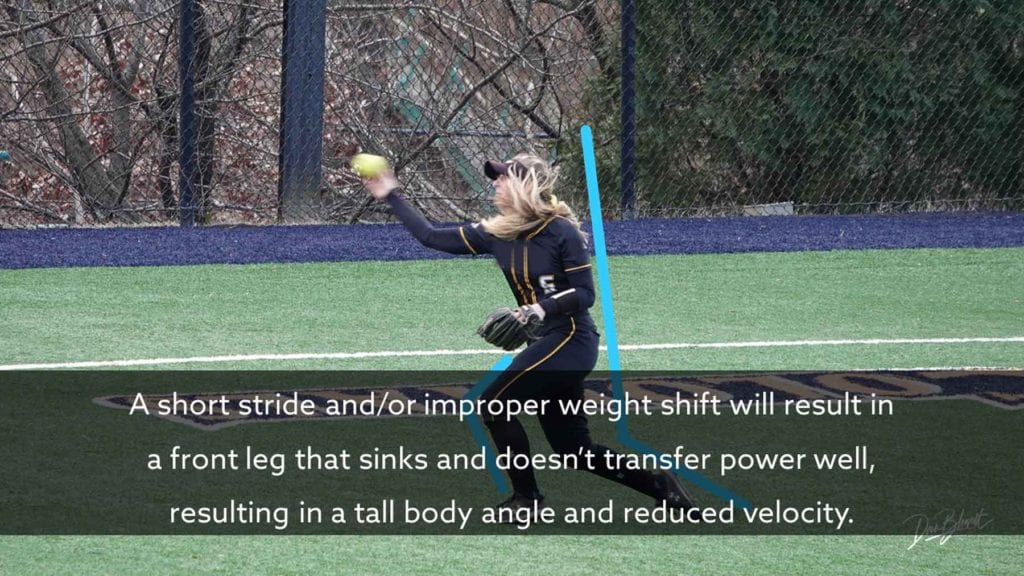
The catcher below also doesn’t use her legs well enough to create a long base of support. Her feet are close together and she has a similarly tall body angle to the outfielder above.
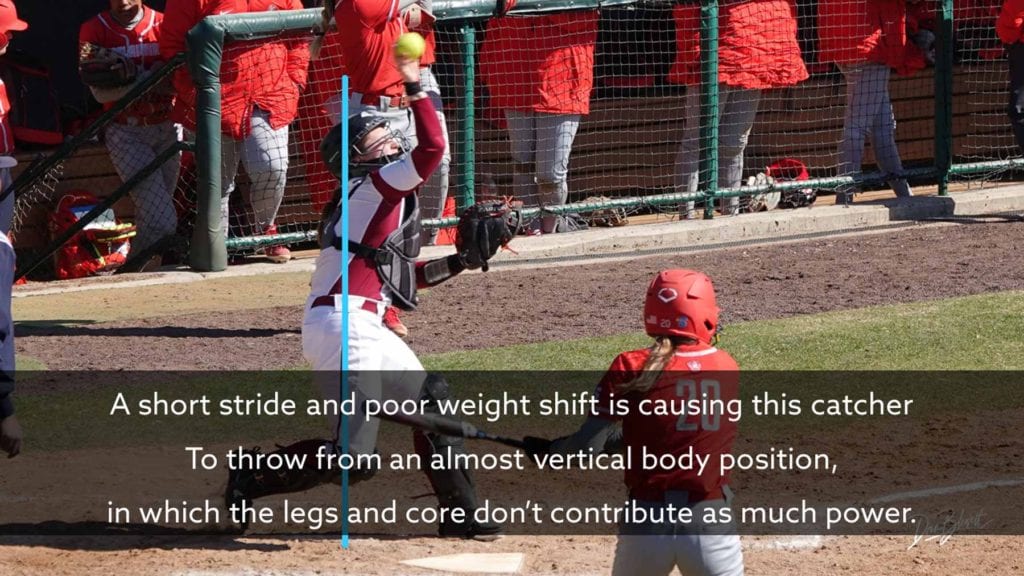
Takeaway: A good weight shift into the back leg = a good stride. A good stride = a good body angle. A good body angle = higher throwing velocities for any softball player.
#9: Chest Direction & Shoulder-Hip Separation
Another huge milestone in softball throwing mechanics is shoulder-hip separation. This is most easily understood as “chest direction” – where the chest is facing when the stride foot contacts the ground.
Watch the video below for a quick, thorough explanation of shoulder-hip separation in throwing mechanics.
Examples of Shoulder-Hip Separation
Shoulder hip separation is seen in both hitters and throwers, as well as pitchers in both softball and baseball.
The concept is simple: the upper body faces away from the direction the lower body is rotating toward. This stretching that occurs–because the body is twisting in opposite directions–causes a rubber band effect when the upper body eventually rotates back through, bringing the arm (or bat, for hitters) with it.
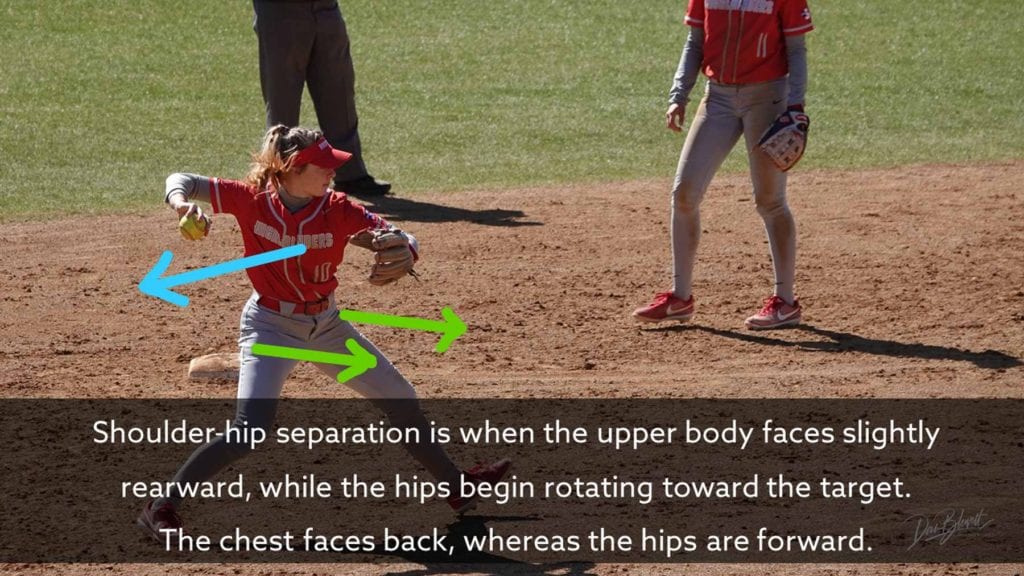
When looking at a player straight-on, you won’t see the logo on their t-shirt or jersey if they have proper chest direction. The chest should face slightly backward, which indicates good shoulder-hip separation.
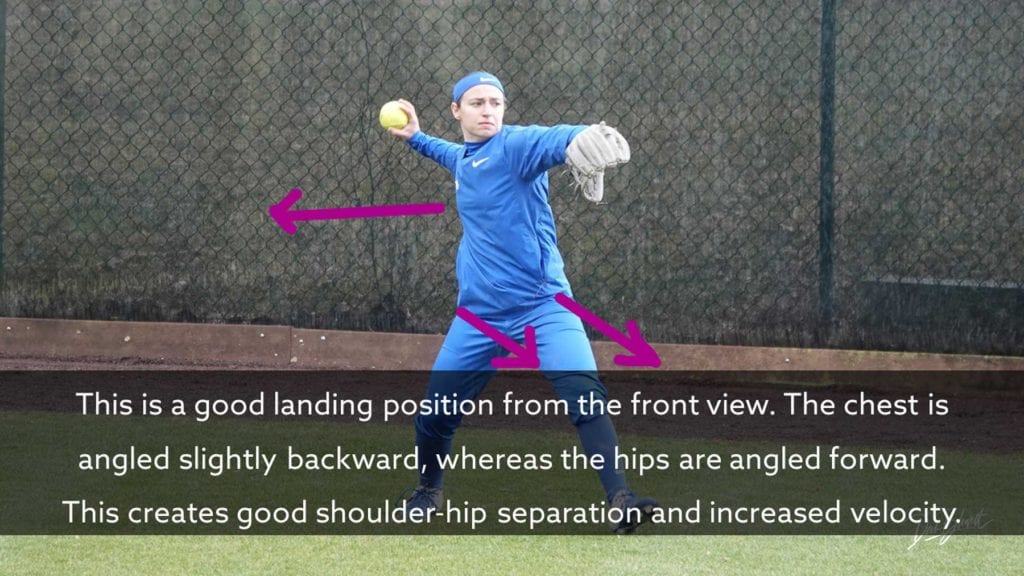
Summary: Shoulder-hip separation is the concept, but chest direction is the big thing to look for: if the chest is facing the target even a little bit, then the player is losing velocity by rotating open too early.
#10: Glove Arm Fold & Fall
The glove arm is critical, as we’ve discussed earlier. It starts the motion of the hips and torso, and creates the proper sync and sequence of body parts accelerating.
But, the glove arm can do multiple things: it can fall down long, or it can tuck by the side. Either is okay.

The big thing, though, is that the glove arm needs to clear the body completely and get out of the way of the torso.
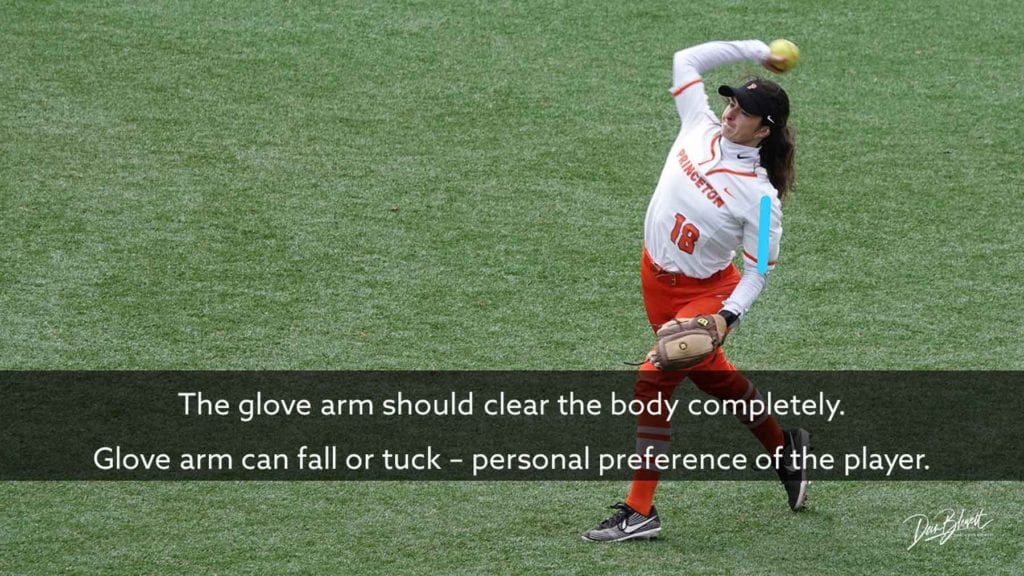
What we really don’t want is for the glove arm to spin out sideways or flop down really long, where it makes the player unstable. Compact and tucked is good as long as it gets clear of the torso, or long (like the player in white above) is okay too.
Lastly, we don’t want the glove to stay in front of the body, which prevents the upper body from rotating as fast and full as possible. However, there is a caviat–when a player throws on the run or is rapidly moving through the ball, the glove will stay in front of the body because it doesn’t have time to get out of the way, and the body doesn’t rotate as much on such throws.
#11: Arm Lays Back
The better a player uses her hips and core rotation to power her arm, the more her arm will lay back at the perfect time. The throwing arm’s layback is external rotation, after which it springs into internal rotation at lightning speed.
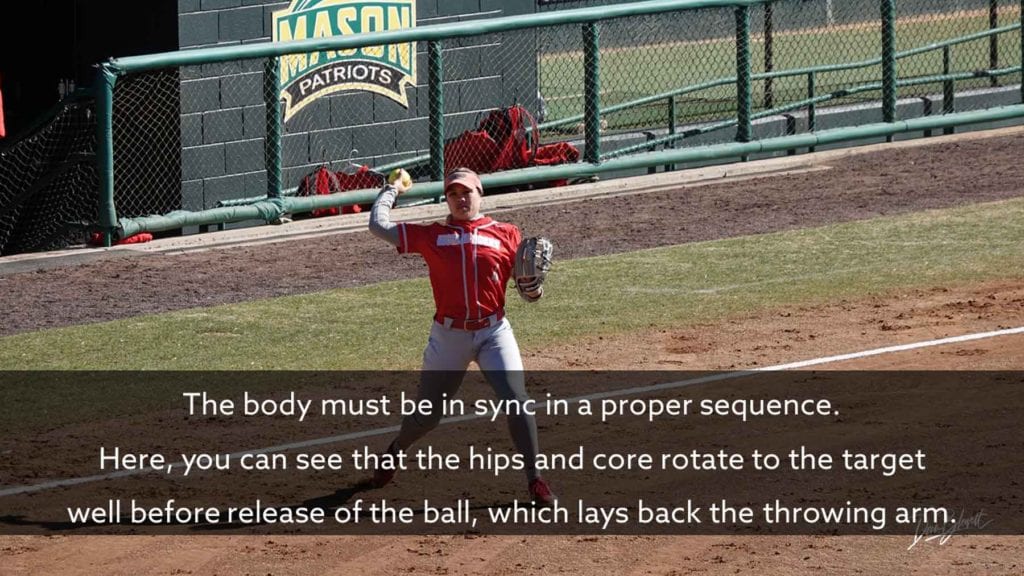
The internal rotation of baseball players’ arms is the fastest human movement, at over 6000 degrees of rotation per second. Check out the video below by Harvard University for more information on the history and biomechanics of throwing.
Throwing arm layback is really important – its how the whip cracks. External rotation looks kinda gross…but the throwing shoulder is adapted to it. Throwing well requires a balance of strength and instability – the shoulder has to be loose enough to move this way, into these somewhat cringe-worthy positions.
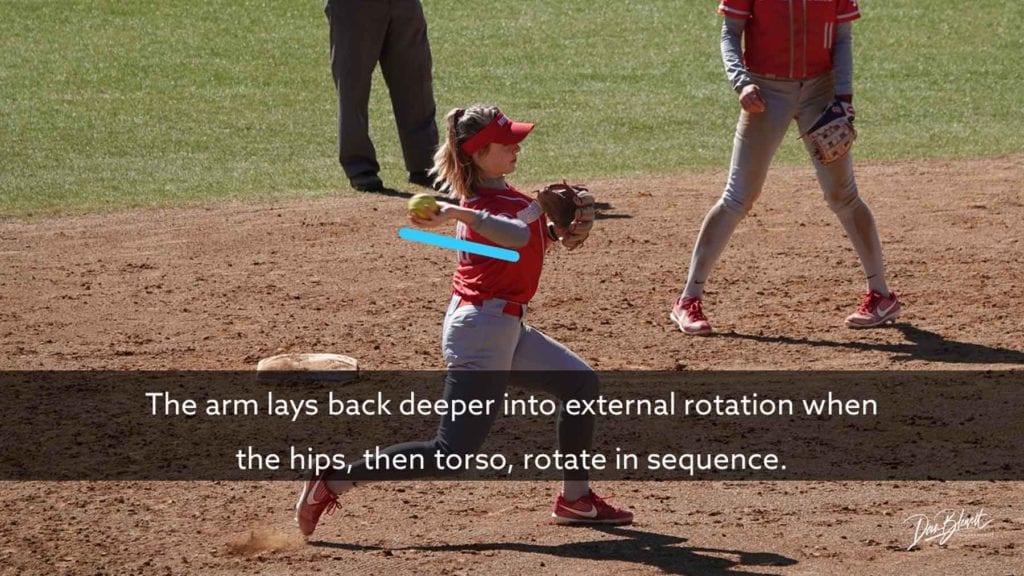
There’s nothing to really coach where layback is concerned, but if a player doesn’t have as much layback as the player above, then something in her mechanics needs to change so that the body can produce more of it.
Without layback, velocity won’t be there.
#12: Shoulder Tilt, Low Elbows & Arm Angle
Pay close attention to this section, as shoulder tilt is very, very, very misunderstood
The low elbow is the symptom of problems with all of the mechanical points we’ve discuss thus far. Is the elbow is low and the player pushes the ball, something is out of whack earlier in the “kinetic chain.”
The kinetic chain is just a chain of muscles/movements that work together in a sequence. When that sequence is off, everything later on is off. The low elbow is the result of a kinetic chain that isn’t working properly.

A common misunderstanding of the low elbow in softball players is that it’s something that can be coached:
Get the elbow up!
Coaches, please listen up: YOU CANNOT COACH A PLAYER OUT OF A LOW ELBOW BY TALKING ABOUT THEIR ELBOW!
Again – this is because the elbow is a symptom, not a cause.
How Shoulder Tilt Impacts Elbow Height
The arm angle MUST match the lateral tilt of the shoulders. Look at this baseball pitcher below and take note at how the lateral angle of his shoulders pretty much exactly matches his arm angle.
This is ALWAYS THE CASE! Arm angle = shoulder tilt. These two variables can never be separated.
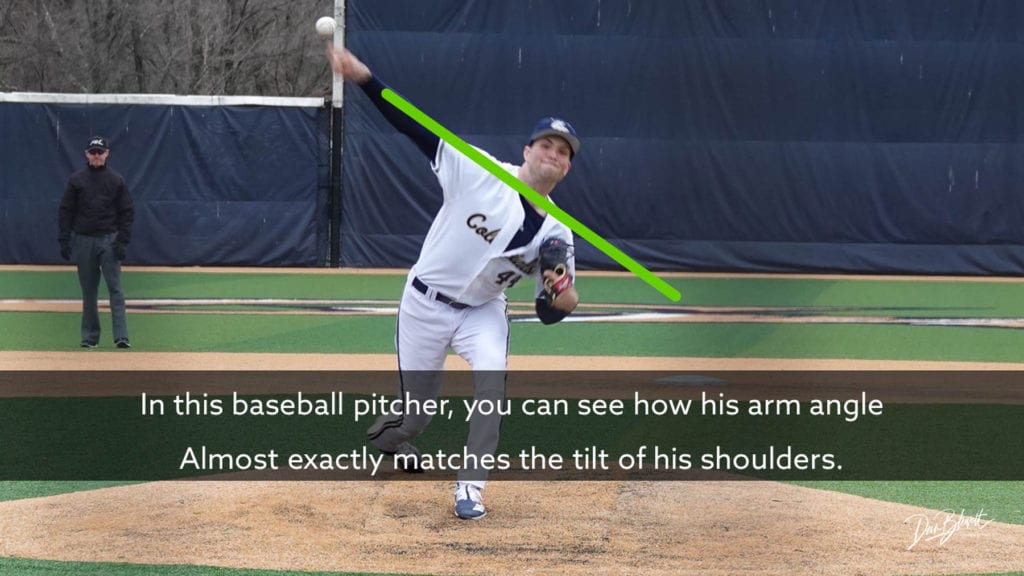
Here’s a softball outfielder showing the same thing: shoulder tilt that matches her arm angle with good elbow height.
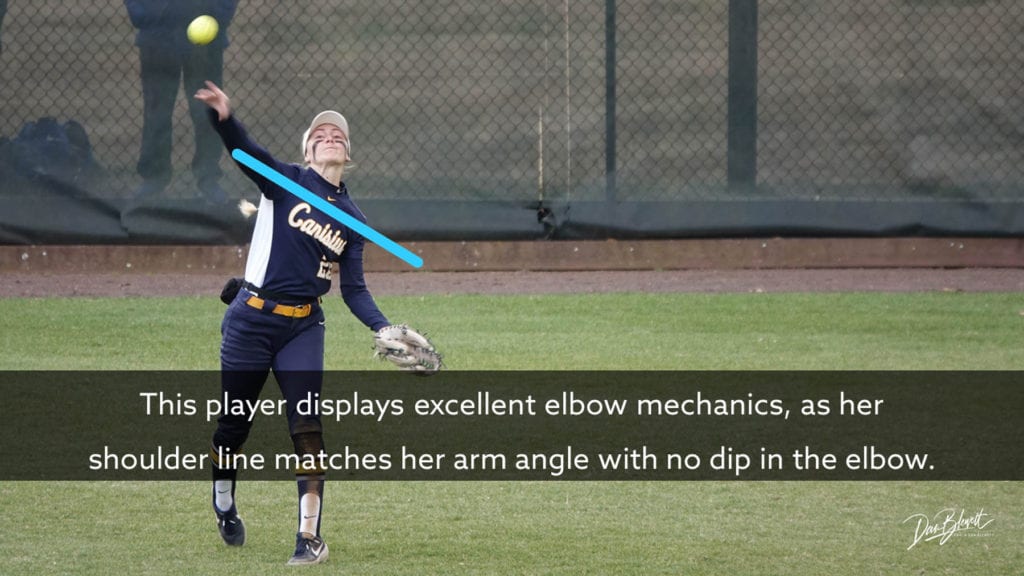
The problem is that most softball players have issues with their elbow height – they have some degree of low elbow. This player below has level shoulders, but her arm angle is too high–this mismatch causes problems. To throw at that arm angle, she needs to crunch her body over and create lateral shoulder tilt to match.

Even amongst Division-I softball players, the majority have some amount of dip in their elbow. This is an unfortunate result of poor teaching methods that have been passed down throughout the history of the sport.
This is what we don’t want:
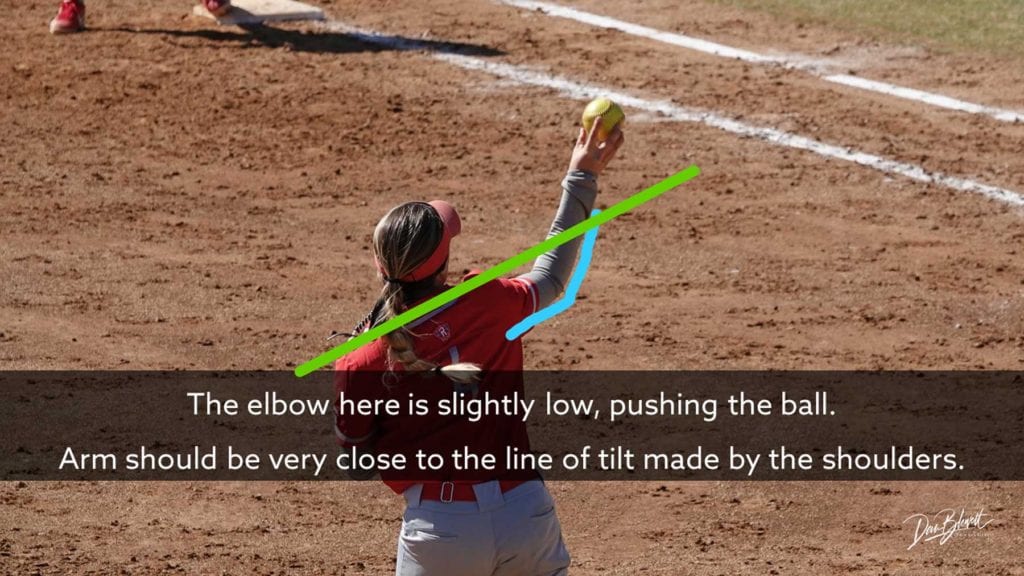
This player shows a very normal-for-softball dip in her elbow. Her elbow is both in front of her torso and because of this, it dips below the shoulder line. When the shoulder blades pinch properly early in the motion, this dip may go away just from that one fix.
Here’s a baseball player who is pinching his arm well behind his body, which helps sets him up for success later on.
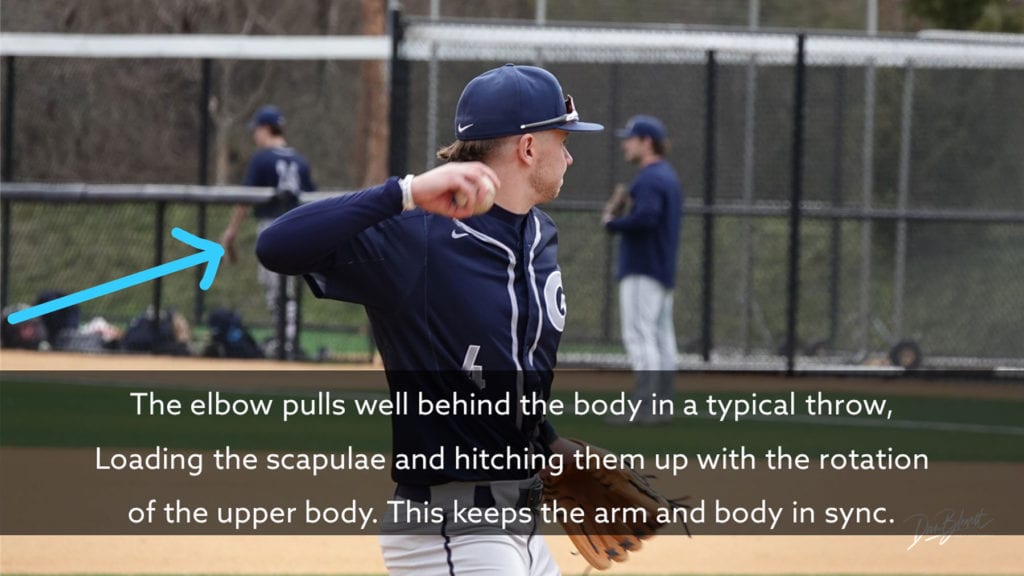
Then, as his body accelerates, his arm stays in line with his torso, instead of jumping ahead and dipping:
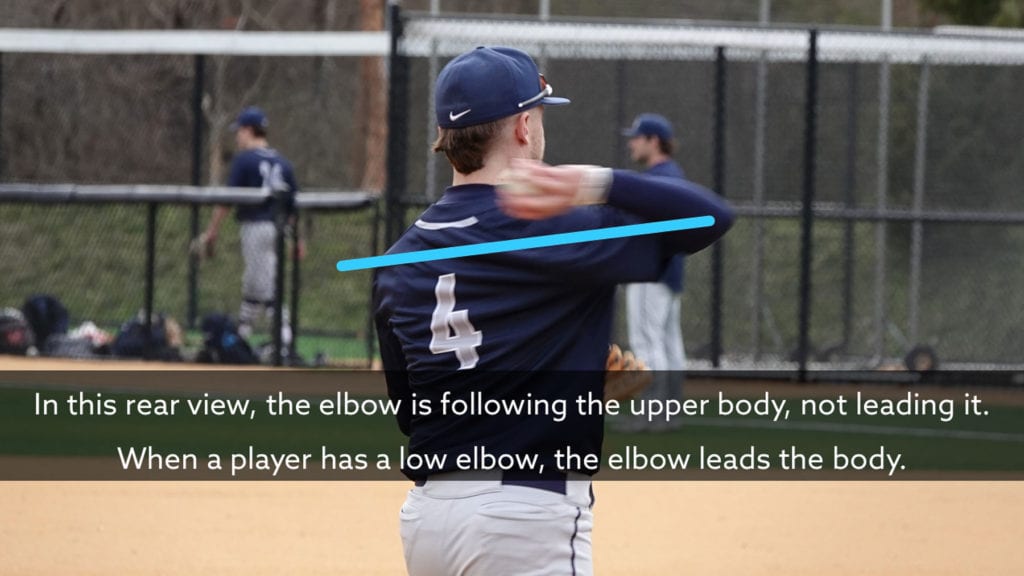
In the photo above, the elbow is in line with the torso, and then will flip up and over when the torso is done its part of the acceleration. Most softball players lack this, and thus they end up with a low elbow.
#13: Chest Moves Forward
We talked about this earlier with regard to stride length, but the chest will move toward the target. This is an important piece of the acceleration phase of a throw. The upper body DOES contribute velocity to a throw.

Again, this part of the throw is related to stride length and weight shift, but it can be coached a bit for players who are just a little too timid in their throwing.
#14: Back Leg Extension
The back leg should stay mostly long if the:
- Stride is right
- Weight shift is right
- Shoulders slope uphill
- Torso moves forward
If all of those things work properly, the back leg should be mostly long when the throw is finally released.

This is another aspect of softball throwing technique that is a symptom, not a cause.
#15: Follow Through
The follow through is a product of the arm angle, which is in turn a product of shoulder tilt. The follow through should:
- Be aggressive
- Be complete – as far across the body as it can go
- Be the same angle as the arm angle
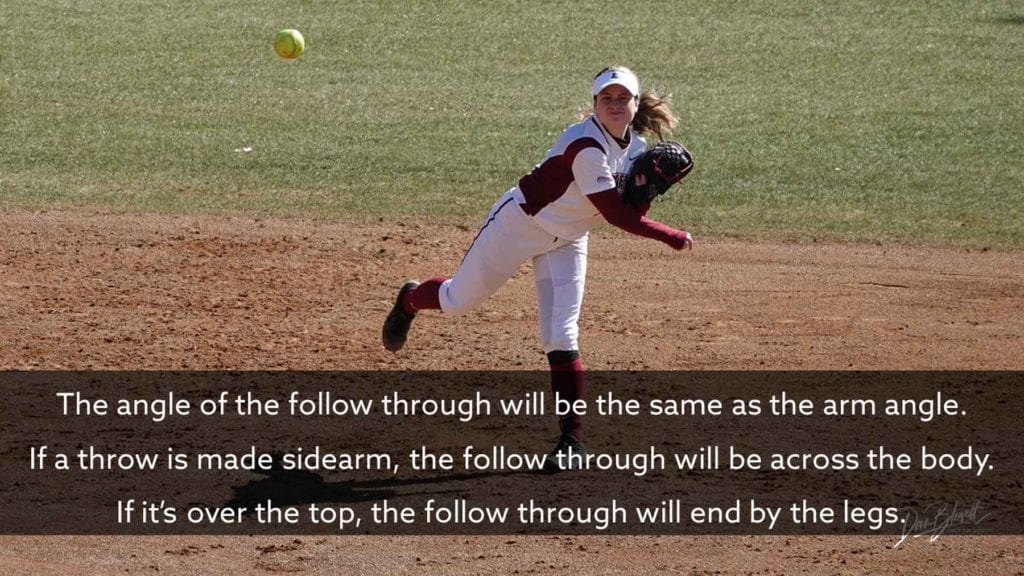
If the follow through is short, it means that the arm started slowing itself down before it had to. This is just giving away throwing velocity.
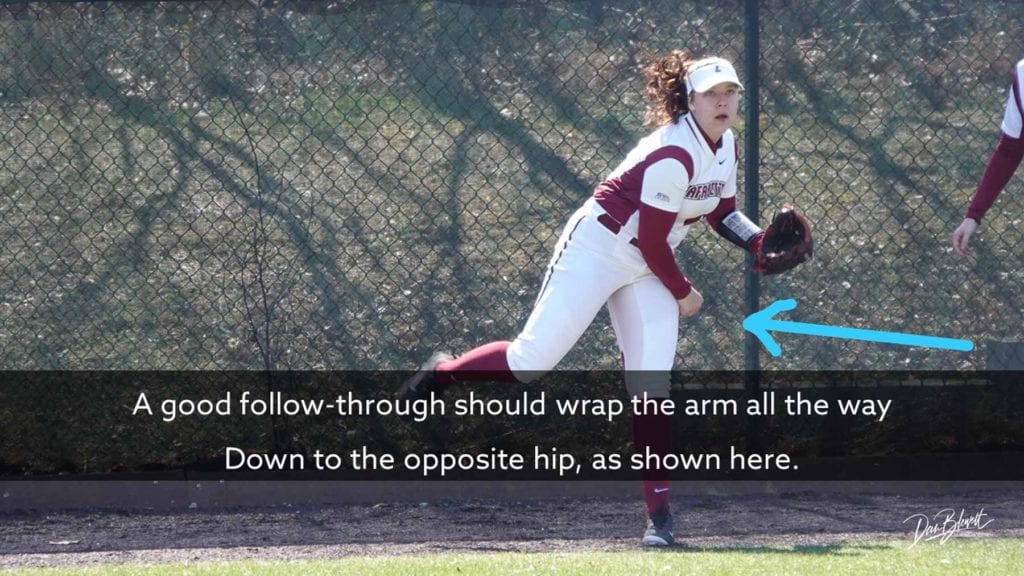
#16: Aggressiveness
Most softball players simply don’t throw like they mean it. They ease off early, and this is partly because of the tiny field that softball is played on. Many throws just don’t require high-velocity to get the job done, so players learn to throw passively and ease off.

But to develop the arm strength that every player should aspire to have, the big dog has to eat! Throw it hard in practice! Long toss and bomb it out, really challenging yourself to see how far you can chuck it.
One issue here is the coaching. I watched a number of D-1 games and watched infielders receiving ground balls 20-30 feet away. It doesn’t matter if it’s a NPF pro player or MLB player, when the throw is only 25 feet, poor, dart-throwing mechanics will be used.
If you’re a coach and you’re allowing your players to make 30 foot throws as part of practice, they will adapt both their mechanics and intensity level to suit. This will hurt them in the long run.
Put your players in a position where they have to THROW THE BALL HARD!
BONUS Softball Throwing Knowledge
Want to learn more about the state of softball throwing instruction? Keep reading…
1 – Why Softball Throwing Mechanics Haven’t Evolved
Softball throwing instruction just hasn’t evolved much with the times. There are two main problems that allow softball throwing technique to lag behind its baseball counterpart:
Problem 1: Out-dated Instruction Methods Aren’t Exposed as Incorrect
In baseball–where slow motion cameras are in use everywhere and we now track mechanics, movements and performances with high-tech systems–softball doesn’t have as much money behind it.
Seeing a MLB player in slow-motion leaves a baseball coach nowhere to hide. If what he teaches is NOT demonstrated by Major leaguers, then he’s going to have a tough time justifying his old methods.
He’ll have to change.

Yet, in softball, lots of old drills and teaching points–things that definitely do NOT work and do NOT teach the right techniques–are still being used. There’s much less high-tech camera equipment to expose it to millions of viewers on TV.
Thus, softball coaches don’t have their old teaching points challenged by video as often as they do in baseball. Baseball coaching is rapidly evolving because we can better determine what works and what doesn’t, and a LOT of money is at stake in making players better.
Problem 2: Coaches Teach What They Were Taught
This is a problem in all sports, where coaches teach what they were taught as young players. The problem? Coaches were young players many years ago, so by default much of what they were taught may not be relevant in today’s game.

Now, let’s be fair and remember that softball hasn’t changed that much in the last few decades–it’s still the same rules, same positions, same core skills. But players are bigger, faster and stronger and the demands of the game have evolved quite a lot.
The metrics by which we evaluate players are might higher than they were just 5 or 10 years ago, so the training and instruction that fastpitch players receive needs to reflect that.
Yet, many coaches still teach what they learned–outdated drills and techniques–when they were taught throwing mechanics years ago.
And with advances in what we’ve learned about throwing on the baseball side of things, there should be a trickle-down…right?
Well, it largely hasn’t happened…at least not yet.
2 – Why Footwork Is Crucial & Improves Throwing Mechanics on its Own
The body is a system–a SMART system.
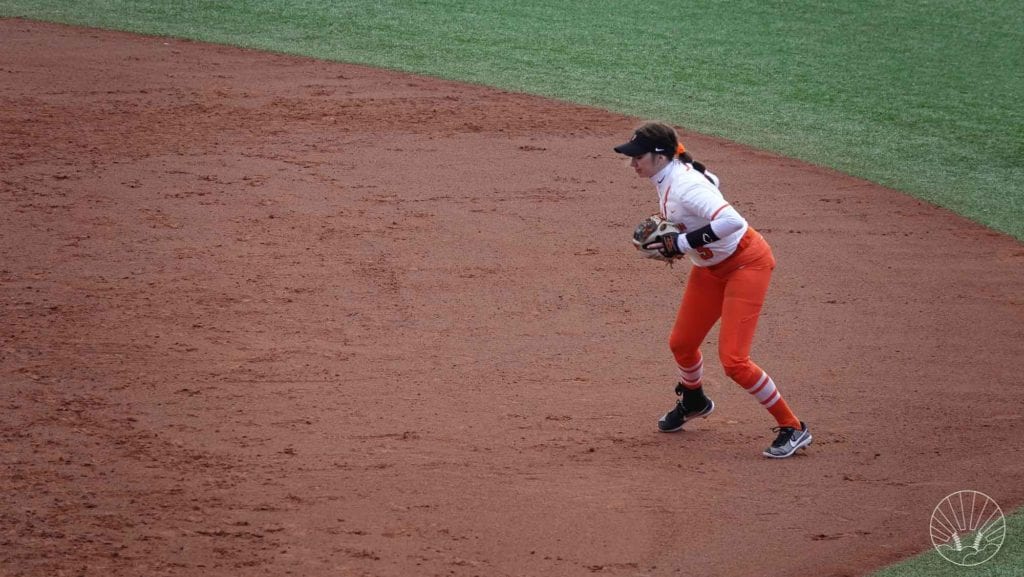
If you give it the right inputs, it will figure out the best output. In throwing technique, one of these inputs is footwork. The faster a player moves her feet, the better her body will figure out how to sync of all the body parts involved.
Many Throwing Flaws Come From Bad Fielding Technique
Throwing flaws start with fielding technique, then move to footwork. To illustrate this point, I want to share a profound experience in my coaching career–a trip to coach an American boys baseball team in the Dominican Republic.
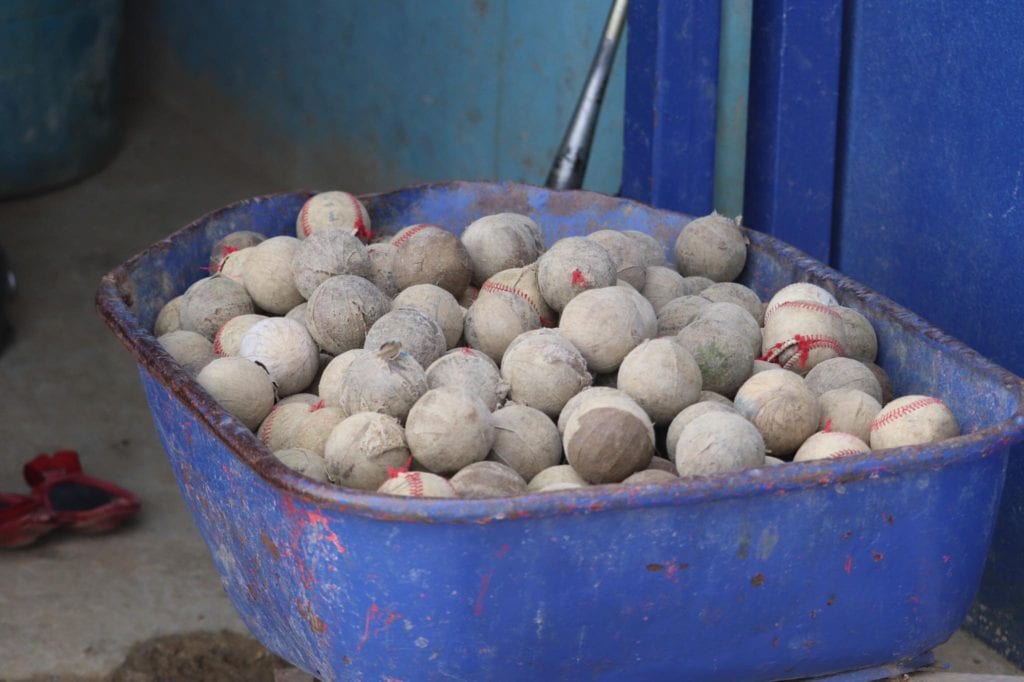
In America, our kids have $400 softball bats, $250 gloves, $120 cleats.
We value equipment hoping that it will enhance skills, when it reality the bang for the buck is downright abysmal.
In the Dominican–where some of the world’s best baseball players are produced despite poverty and hand-me-down, ragged equipment. The re-use old baseballs by taping them out time and time again.

Yet, these players can REALLY throw. I watched them warm up and quickly noticed a pattern:
The players with great arms moved their feet. ALWAYS.
And it hit me–because these players get the ball, mimic their fielding motion then rapidly shuffle their feet before every throw, they’re forcing their body to move fast and get in sync.
The Dominican teams–top to bottom–had cannons for arms. And it wasn’t because they did better drills, had better equipment, or even a more regiment throwing routine. It was really that they just threw a lot, worked hard, and always moved their feet aggressively before every throw.
I really, truly believe this is a major detail, one not to be overlooked.
Moving Your Feet Forces Your Body to Work Together.
American players’ throwing routines are VERY different, and most players lazily toss the ball to their throwing partners, barely moving their feet, stepping in a poor line to their target while flying open with their chest and barely using their front side.
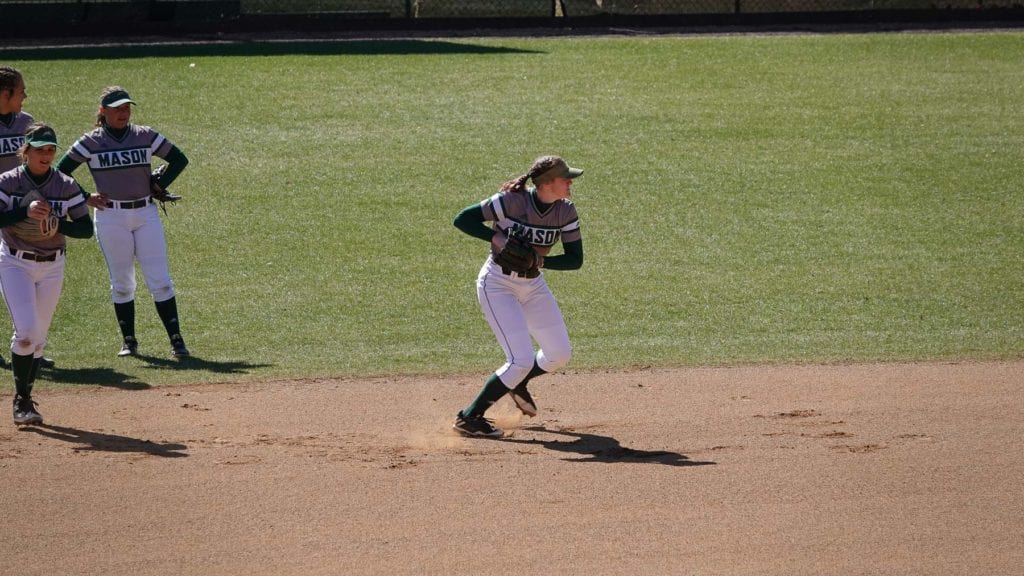
This way of throwing ingrains bad habit after bad habit, then we scramble to fix them later on.
Takeaway: if you do one thing, force your players to take two aggressive, fast shuffles before every throw in practice.
Their body will begin to fix their throwing mechanics naturally over time…because the body is smart and efficient with movement.
When coaches call me for one of my free consultations, I try to impart the #1 thing they can do–today–to make an impact on their team. Without a doubt, my number
3 – Why Fielding Technique Is Critical to Good Throwing
Let’s start with an analogy: where does the quarterback hold the football?
At his chest, right? Right. Why does he hold it there?
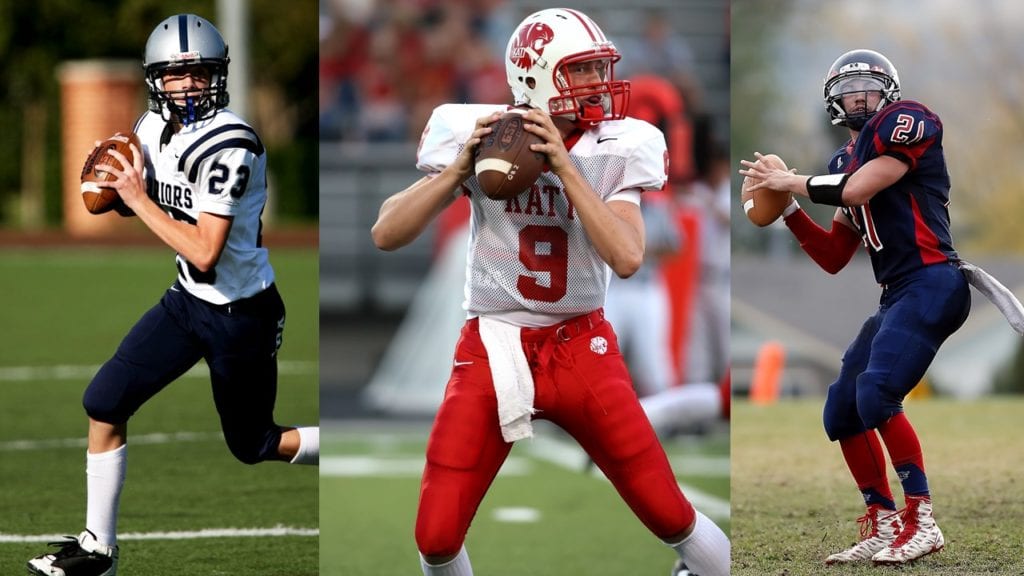
Because he doesn’t know yet where he’ll be throwing the ball.
So if he keeps it at his chest until it’s time, his mechanics will be the same no matter what direction, distance or angle he throws from.
Ball at Center = Consistent Throwing Mechanics
In softball, we want repeatable mechanics that allow for good accuracy and velocity. And, the direction and distance we throw will literally be different on every single throw.
Sure, a shortstop makes a lot of similar throws from short, but none of them are ever the exact same angle, speed or have the same time constraints (such as how fast the runner is and how much time she has).
To ensure the most consistent throwing mechanics, a fastpitch player needs to “funnel” the ball to her center when she’s squared up to a ground ball. Then, she will have it at her chest so she can make the throw when her footwork is correct and she’s taken the amount of shuffles she wants to make.
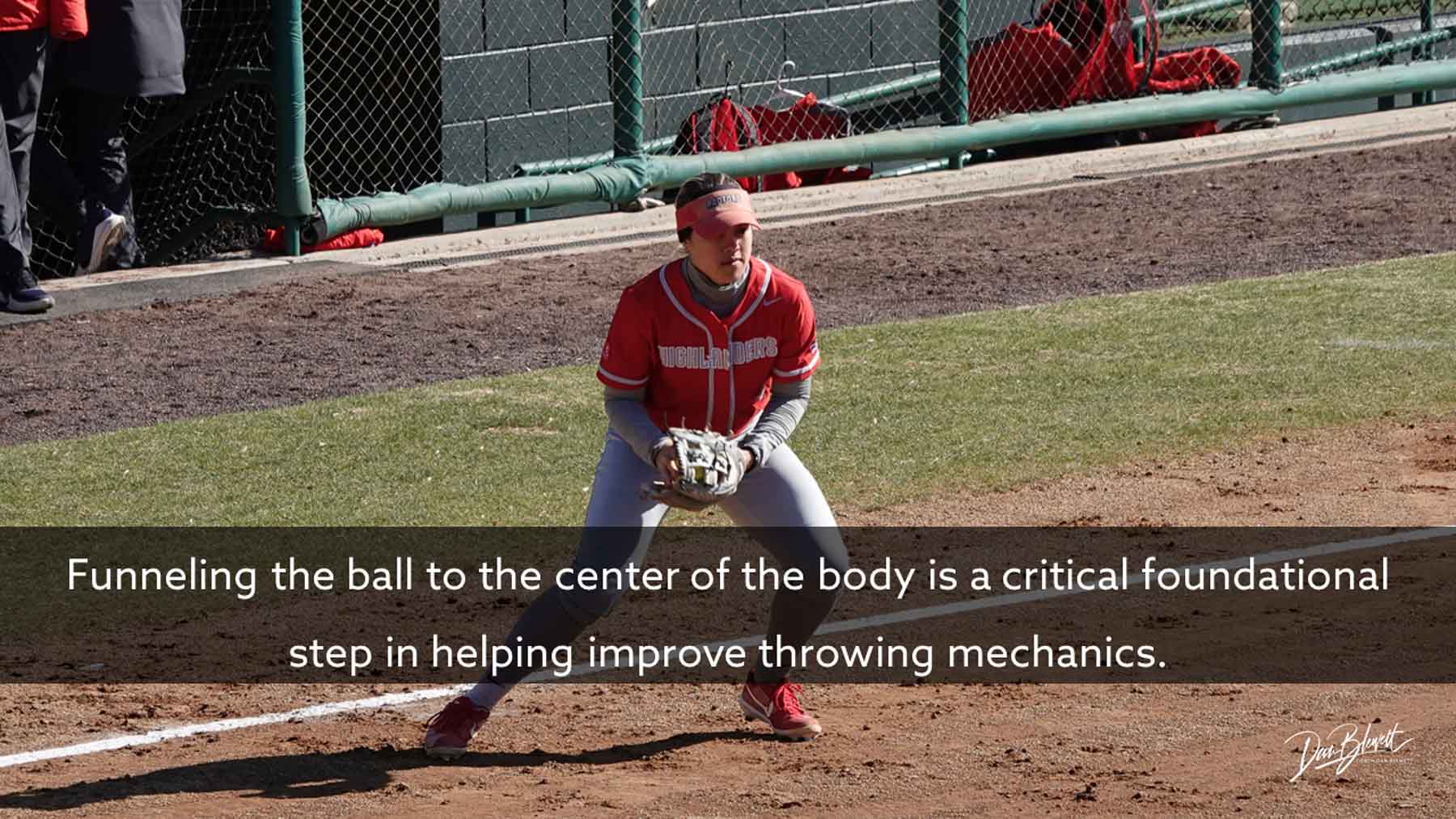
Learn more about “funneling technique” for infielders here.
We want the ball funneled up to the center of an infielder when she’s square to a grounder. That way, she has it at her center and is in a good throwing starting position no matter what type of throw she has to then uncork.
Takeaway: When the ball is fielded and funneled to the center, the arms start in the same position and move the same distance on every throw, thus making throwing mechanics more consistent.
It’s just like the quarterback – he keeps it in the same place so his mechanics are the same before every throw, no matter which receiver is on the end of it.
4 – Throwing Sidearm, on the Run, and From Weird Angles
Throwing overhand is the foundation for fastpitch players, but it’s certainly not the only way. When on the run, throwing will almost always be best done sidearm – it’s easier on the body and shoulder.
When moving to the right as an infielders, lower-than-sidearm arm angles are typically the best tool for the job. All of these different angled throws are important tools for a softball player to have in her throwing toolbox.
Watch the video below for an in-depth tutorial on throwing from different arm angles.
For coaches, be sure to let your players practice tough throws in a safe environment where it’s okay to make overthrows and not be perfect. Practice is practice, and for these tough, weird throws to stick, they need repetitions in practice.
5 – Softball Catcher Throwing Mechanics
Catchers adhere to most of the same rules of throwing as every other position, with only minor tweaks. But don’t take it from me – watch the video below with tons of slow-motion D1 catcher footage and pro baseball footage.
Catchers have a tough job, and focusing on throwing mechanics should be a part of every softball catchers’ throwing progression.
How to Make a Big Throwing Mechanics Change
Need to make a big change and really take the time to improve your mechanics?
Use this guide and watch the videos on my YouTube channel. If you want something more customized and deeper, check out my softball throwing course below:

It’s full of good information that you can use to help improve your throwing velocity today.
Get Bigger & Stronger and You’ll Throw Harder…
Try the Early Work Online Softball Training program today – get a 14-day free trial and nothing to lose.
Softball Throwing FAQ
Have a question? See if its answered below from our commonly asked questions.
Why is throwing sidearm bad in softball?
It’s not necessarily bad! Throwing sidearm has its place in softball – it’s a tool that infielders and catchers use when throwing on the run, when off-balance, or when they want to quickly get rid of the ball. Sidearm throws are less powerful, but they are faster than overhand throws. So, they can be valuable for certain situations. Yet, many softball players throw sidearm accidentally – they throw that way all the time, in all situations, because they have flaws in their mechanics. Improving throwing mechanics will usually help a player’s “default mechanics” become more over the top and less sidearm.
How do you throw a softball for more distance?
Adding distance to your throw is simply adding velocity with good mechanics. When throwing longer distances, you’ll have to throw the ball at a slightly higher trajectory (though not too high like a rainbow). When you throw these longer distances with a higher trajectory, the shoulders will naturally angle slightly upward to match this angle. So throwing farther starts with a good weight shift–keeping the weight in the backside longer–so that you can produce this quality upward shoulder tilt. Beyond that, throwing farther means throwing harder, so improving mechanics, getting bigger and stronger in the weight room, using rotator cuff and shoulder strengthening exercises, and improve your grip and spin on the ball–all of these factors will help you improve how far you can throw.
Why does my elbow hurt after throwing a softball?
This is a good question, and one that can’t be answered for certain over the internet. However, a handful of causes could be behind your elbow pain:
1. Your throwing mechanics aren’t good enough, causing more stress on your elbow.
2. Your shoulder blades are weak and cause further mechanical problems.
3. You are being overused – making too many throws per day or per week without proper recovery or exercises to care for your arm.
4. You need an arm exercise program to strengthen your throwing arm. This is important – if you’re having pain, strengthening your shoulder can make it more resistant to both shoulder pain AND elbow pain. The two are linked.
How do you throw more accurately in softball?
Accuracy comes from good, repeatable mechanics. It also comes from not overthinking, guiding or aiming the ball. If you’re aiming the ball, you’re making it harder for your body to do what it’s practiced doing – throwing the ball. When you don’t overthink, you allow yourself to be the best version of you. Accuracy comes both from working on your mechanics regularly and following a great throwing routine, but also from trusting yourself to throw it hard, without thinking, and without interfering with your body.
How fast do college softball players throw overhand?
About 60mph, with many of the best reaching into the mid-60s. So, if it’s a player’s goal to play collegiate softball, working consistently on developing powerful, accurate throwing mechanics is a must. 60mph is a great milestone and is also very achievable for nearly every player with a good work ethic and proper training.
